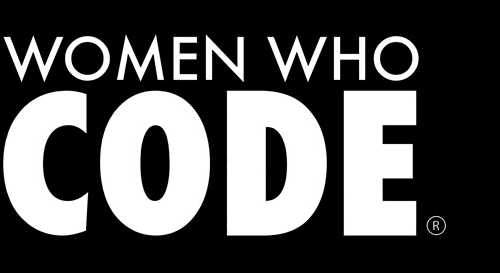Radical Networks 2019 Exhibition
The Well Bottom by Alden Rivendale Jones

The Well Bottom is a simulated pocket network, pulled from an alternate history of the Internet in which the network's cyberswamps were never paved over to build the information superhighway. It's a place for becoming lost.
FANGo, a Facebook, Amazon, Netflix, Google Obfuscator by Martin Nadal

FANGo is a defense weapon against surveillance capitalism. Hidden under its appearance of mobile phone charger will be provided with a micro controller that takes control of the smartphone plugged in making queries to google, amazon and other search engines, launching videos in YouTube in order to deceive data brokers in their data capture process.
Facebook, Amazon, Netflix and Google were grouped under the acronym FANG as the most important and high-performing companies of the NASDAQ and pioneers of what is known today as surveillance capitalism.
In a similar way as industrial capitalism through its mechanics turned nature or work into a commodity such as real estate or labor, surveillance capitalism turns experiences that occur in the private sphere of the human being into commodities that can be bought and sold.
The difference of this type of capitalism is substantial as it integrates the human experiences of private realm in the production processes without the individual being fully conscious. This affects the economic sphere but also the independence of the human being, because with the logic of maximizing profits the companies will try to modify the user's behaviour without the user being able to do much to defend himself. The aim of the project is to disrupt this mechanics, adding noise to the captured data, making it difficult to transform the captured user data into predictions, thus devaluing the value of the extracted data.
Liquid Router by Emma Rae Norton, Nicholas Gregg, and Sukanya Aneja
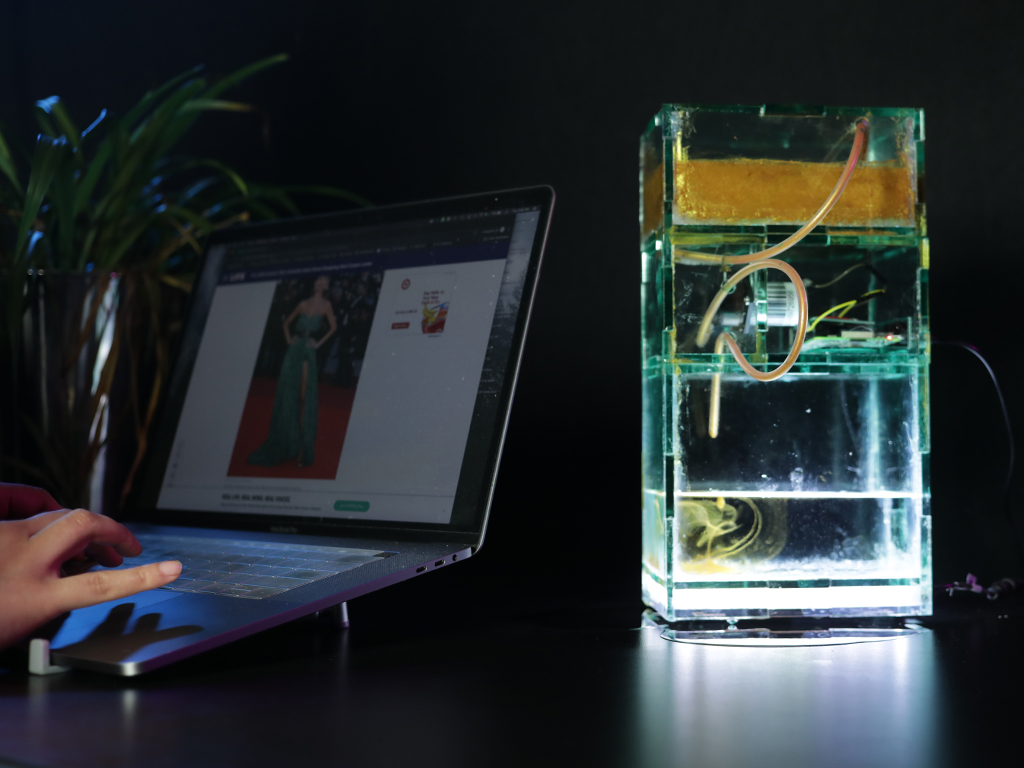
Liquid Router is a physical artwork that takes the form of an active Wi-Fi router––using the router as a medium to explore and demystify the implications of third-party web tracking. Through this project we are interested in asking questions of the development and architecture of hyper-scale tracking systems. We are also committed to raising awareness around the lack of transparency built into them.
The Liquid Router is built with a Raspberry Pi, and provides users with a wi-fi network to connect to. As they browse the Internet, the router 'leaks' liquid every time a request is sent to a known third-party tracker. Colored liquid diffuses into clear liquid, serving as a metaphor to the difficulty in quantifying and isolating the effects of these tracking systems. The router also displays information about the individual tracker, putting a face to this invisible background activity. Information on how this technology works, and the entire landscape around data harvesting will be disseminated through the form of a zine.
Slow Net by Beverly Chou
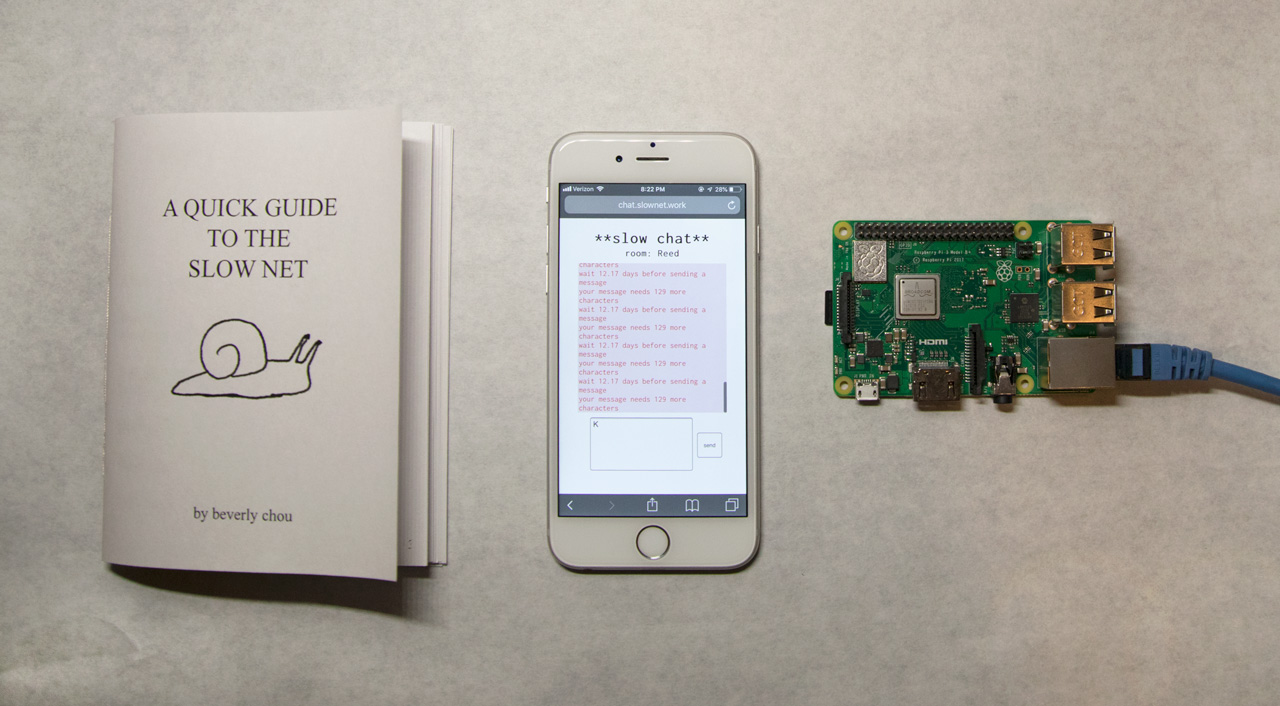
Privacy concerns have made news headlines recently, and it’s clear that our behavioral data is collected when we’re online. Some of the data is used for improving user experience, but much of it is used to predict and influence our behaviors in real-time. Data collectors can use the data to intervene and divert our actions. In this process, humans are reduced to interchangeable pieces of data in a homogenous population of data laborers. As a result, power and wealth is concentrated among those who are able to collect and gatekeep vast amounts of information. Our identities get privatized and our autonomy is threatened.
Because real-time collection of data is enabled by fast Internet speeds, one form of resistance could involve co-opting a tactic from labor unions called the slowdown strike, in which workers deliberately reduce their productivity. Slow Net aims to utilize this strategy of purposeful inefficiency in three pieces.
- A zine called A Quick Guide to the Slow Net provides context about the problems underpinning online data collection and how slow networks could be used to resist data-collecting companies.
- An online messaging application, Slow Chat, forces users to write longer messages and wait longer between messages as conversations progress.
- A Slow Router provides free wifi at a much slower speed than expected.
Each of these pieces functions with the goal of slowing the capture of personal data, encouraging more intentional action, and creating opportunities for idle time that allow for introspection and self-development. Collectively these actions attempt to preserve our autonomy and identity. My hope is that as users we can reconsider our relationship with many of the internet platforms we use that exploit us, and as technologists we can re-examine our role in working with and developing these technologies.
Remembering Network by Sarah Friend

A memorial to biodiversity loss, hosted on the p2p web
There are 41,415 species on the International Union for Conservation of Nature’s Red List of Threatened Species, and 16,306 of them are threatened with extinction. It makes up 27% of all assessed species, 40% of amphibians, 25% of mammals, 14% of birds, and 70% of assessed plants. Early this May, the United Nations released a report on global biodiversity loss, finding that it is in unprecedented decline as a result of human activities.
Take a deep breath and hold that in your mind. As we try to preserve and rebuild our world, we must also bear witness to the losses that came from our past carelessness.
The Svalbard Global Seed Vault is a highly secure seed bank meant to preserve genetic information for future civilizations located on a remote island in Norway. Increasingly, it serves as a memorial, but it’s not accessible to most people as anything more than an idea. Remembering Network is also a kind of monument - but one that is collaborative, local-first, diverse, and resilient - to lost and threatened wildlife. It will contain crowdsourced images and genetic information of currently threatened and endangered animals.
Attendees are invited to submit images of animals, to be packaged in archives on ipfs and other peer to peer protocols. Much like the seed bank, which is built to withstand many kinds of extreme climate and weather, peer to peer protocols are similarly designed to withstand network failures and takedown attempts. We'll put our memorial in the safest place we know: all over the world, everywhere.
Sound and production assistance from Arkadiy Kukarkin
PhotoLink by Jasmine Soltani
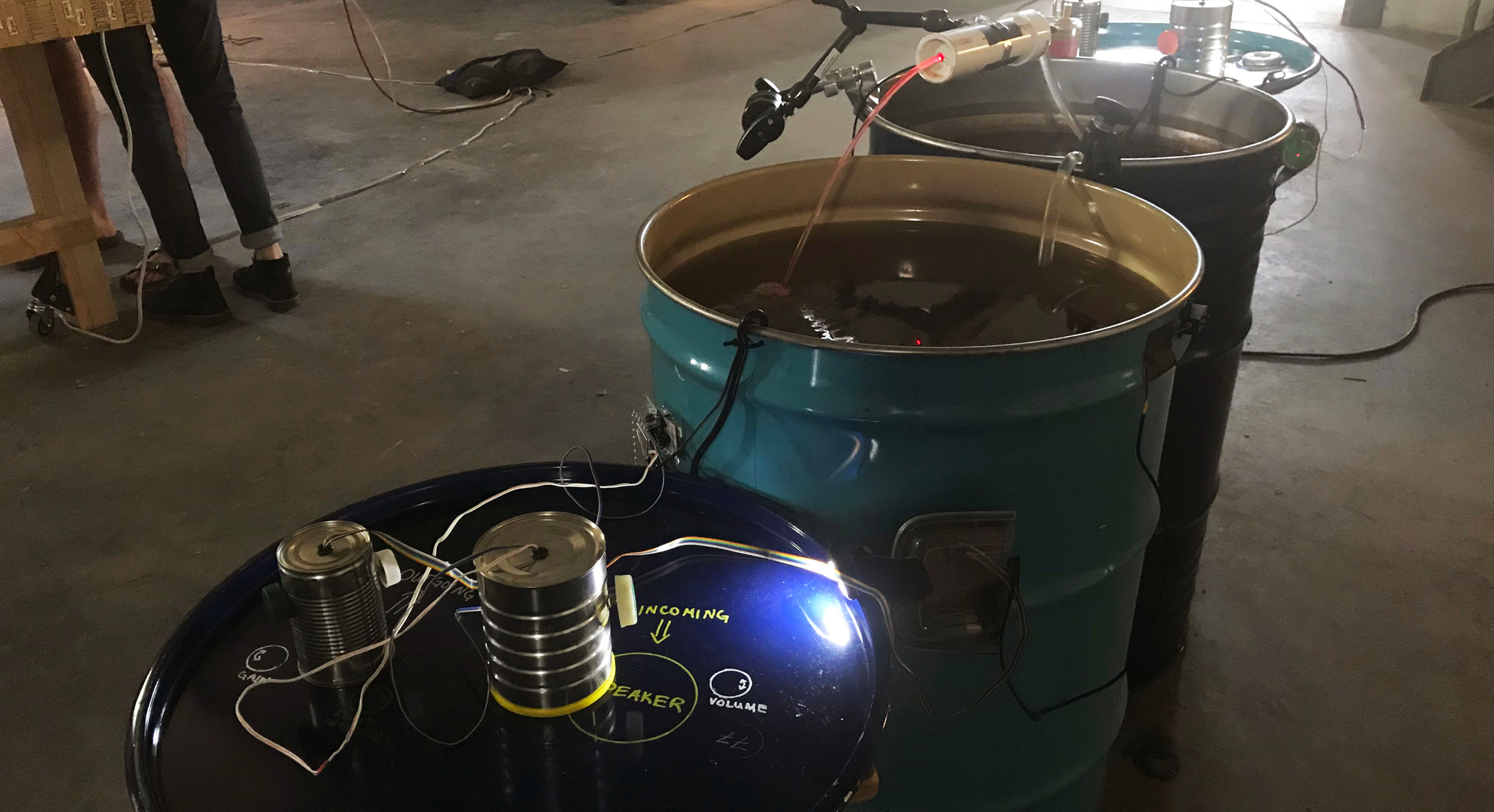
In the early 1800’s, Jean-Daniel Colladon demonstrated the principle of total internal reflection with water “light pipes” which led to the development of fiber optic cables. Using analog AM lightwave transmitter and receiver circuits from Forrest M. Mims III’s Engineer’s Mini Notebook: Optoelectronic Circuits, PhotoLink shows audio traveling as an optic signal through water laser pipes. Water flows through laminar flow nozzles going in two directions, which carry a visibly modulated signal, demonstrating how fiber optics work. Visitors can have a conversation using speakers and microphones at either end. The majority of the installation is built from reclaimed materials.
(no)control by Esther Bouquet
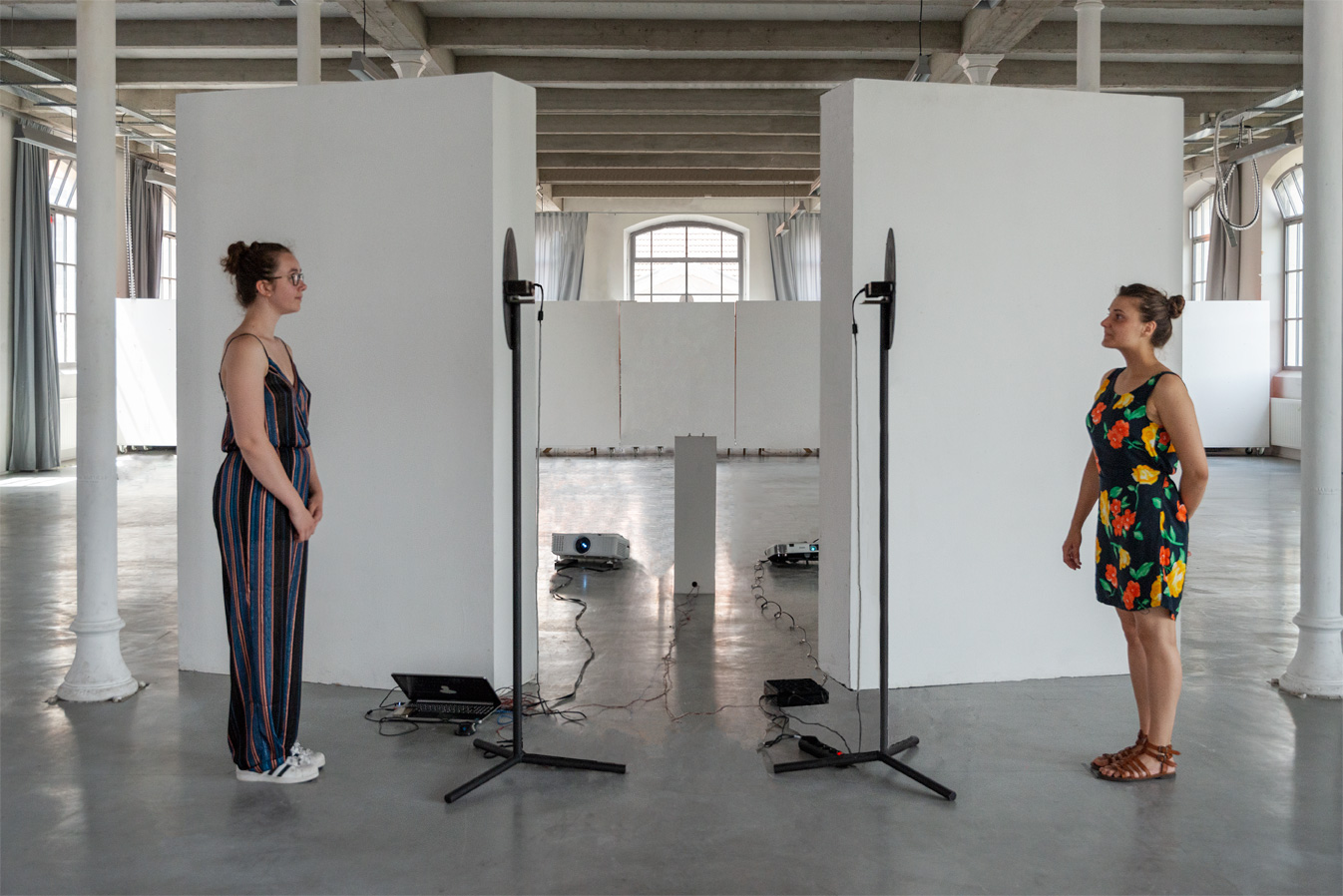
Considering the web as a free space where our private life can still be preserved often implies forgetting the strong implications and conflicts linked to the data we generate while we browse and which build our digital identity. As those tracks are collected, indexed, stored, copied, combined and agregated with each other, they raise control and surveillance questions on the network. This hidden and insidious design of control is developed by and for companies. It thus shapes a society focused towards an extreme rationalisation, that advocates for transparency while maintaining opacity regarding its infrastructures.
(no)control tries to unveil the mechanisms of control and their asymmetry on the web by physically embodying them. The kinect captures the face of person A standing/walking in front of the mirror structure. The person can only go back and forth or slightly move in front of it and see their face reflecting in the mirror. They cannot help but notice the camera, however interacting directly with the displayed result is impossible as the mirror structure is behind the wall where the kinect feed is projected. They embody the web users. It is person B, emboying a corporation, who can see, interact and thus control what the kinect captures. A potentiometer enables this person to have control over the portrait of person A. By turning the knob, they can manipulate as they wish the representation of the web user. They can display from a very detailed to a more geometrical face.
This installation tries to illustrate how data based companies process, control and manipulate our data without our consent, awareness or involvement. The web user can never see what the corporation decides to render while the corporation has a complete takeover.
Here Be Dragons by Phillip David Stearns
Here Be Dragons transforms malicious network traffic, attacks on servers located around the globe, directly into sound. The project is an exercise in using the sense of sound to experience low intensity cyber conflict. Virtual Private Servers are configured as honeypots and forward copies of in and out bound packets to raspberry pis installed in the gallery. Port scans, exploit attempts, brute force login attacks, and other forms of unwarranted traffic are made audible in real-time through headphones. A guide to identifying the sonic signatures of such attacks will be accessible online to accompany the piece.







